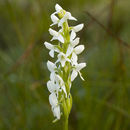en
names in breadcrumbs


Platanthera dilatata, known as tall white bog orchid, bog candle, or boreal bog orchid is a species of orchid, a flowering plant in the family Orchidaceae, native to North America.[2][3][4] It was first formally described in 1813 by Frederick Traugott Pursh as Orchis dilatata.[5]
It is sometimes called fragrant white bog orchid or scentbottle, for the smell of its flowers, described as intensely spicy or clove-like.[2][6][7]
In the Midwest and northeastern United States and Canada, it grows in cold, calcareous fens, cedar and tamarack swamps, meadows, and marshes, typically in sunny spots.[3][4]
Bog candle is an erect, perennial flower growing up to 11–130 cm (4.3–51.2 in) tall. The showy, white flowers are clustered on long spikes. The petals are ovate to linear-lance shaped with smooth edges, not divided or fringed like some other Platanthera species. The lateral sepals spread or reflex.[2][3]
The leaves are linear to lanceolate or oblanceolate, and reduce in size toward the top of the plant. The leave size ranges from 3–32 cm (1.2–12.6 in) long to 0.3–7 cm (0.12–2.76 in) across.[2]
Inflorescence, British Columbia
Three varieties are accepted:[2]
British Columbian Native Americans used the sweet-smelling flowers in washing themselves.[8]
Platanthera dilatata, known as tall white bog orchid, bog candle, or boreal bog orchid is a species of orchid, a flowering plant in the family Orchidaceae, native to North America. It was first formally described in 1813 by Frederick Traugott Pursh as Orchis dilatata.
It is sometimes called fragrant white bog orchid or scentbottle, for the smell of its flowers, described as intensely spicy or clove-like.
In the Midwest and northeastern United States and Canada, it grows in cold, calcareous fens, cedar and tamarack swamps, meadows, and marshes, typically in sunny spots.